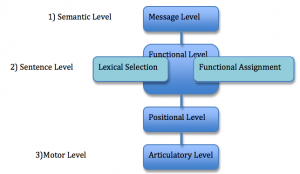We have all seen it happen. It has happened to each of us. It is the utterance of something embarrassing that we didn’t mean to say. We were thinking of something completely different, but it just came out wrong. Sound familiar?
Check out this example of a Freudian Slip!
In the above clip from the TV show “Friends,” Ross is saying his marriage vows to Emily, but mistakenly says Rachel. In the context of the plot, this mistake was clearly meant to reveal the suppressed feelings that Ross had for Rachel.
The type of error shown is called a Freudian Slip, and is one of the more common speech errors. So, what comes to mind when you encounter the term Freudian Slip? Most people think of revealing scenarios, similar to the clip from “Friends.” This is because Freud theorized that these scandalous slips of the tongue really revealed the speaker’s suppressed thoughts. Check out this other example featuring George Bush.
In this clip of George Bush giving a speech, Bush describes his collaboration with Reagan, mistakenly saying “sex” before correcting himself to “setbacks.” He did not actually intend to suggest anything sexual about their professional collaboration. However, “sex” and “setbacks” have similar phonological pronunciations, including the ‘s’ and ‘e’ phonemic sounds at the beginning of both words and the phonemic sound shared by ‘-x’ and ‘-ks’ at the end of the words. The similarity in articulation of these words suggests that this slip was the result of a speech error, rather than unconscious thought.
While there are many examples of speech mistakes that reveal information, most of us commit everyday speech errors that are seemingly random. So, is there more to the process of language production that can explain the seemingly random mistakes people make in everyday speech?
Let’s take a look at the brain regions and cognitive processes involved!

The major brain region for speech production is called Broca’s area, and is located in the frontal lobe as seen in the image above. This has been discovered through research on patients with damage to this region of the brain. Patients with damage to Broca’s area exhibit deficits in language and speech production to varying degrees corresponding to the severity of the damage. However, everyday speech is filled with a variety of speech errors, even for people who do not have damage to this brain region.
So, how do speech errors occur based on the speech production process?

The speech model shows the process of transforming the conceptual representation, what a person wants to say, to the motor controlled production of the phonological word or phrase that conveys that concept. During the production process, there is competition between words that have similar semantics, syntax, and pronunciation. There are often many different ways of conveying the same idea. The semantic nature, or word meaning, impacts speech errors when one is selecting between two synonymous words. The result is that these words combine to be mixed up in a multitude of ways.
Check out this clip of Cady and Aaron from Mean Girls (2004). This shows a speech error resulting from lexicalization, which is the process of selecting a word based on meaning. Cady’s speech production system is selecting between synonyms that are the same part of speech, “cool” and “great.” Both are perfectly acceptable choices given the context. However, Cady slips up by combining the two competing words into “grool.”
Words can also be completely or partially repeated to produce a stutter. A similar sounding word might be chosen instead of the target word simply because they sound the same, even if they have entirely different meanings. Certain syntactical characteristics tend to be preserved through the occurrence of speech errors, such that words tend to be replaced by other members of the same grammatical class, for example, nouns replacing nouns. This results from the independent processes of lexicalization, also known as lexical selection, and functional assignment, which determines the syntactical characteristics based on rules of grammar and word context.
It is important to note that speech errors can be introduced in a research environment through SLIP tasks (Spoonerisms of a Laboratory Induced Predisposition). A spoonerism is a speech error in which the initial consonant sounds are swapped between words, such as saying “belly jean” in place of “jelly bean.” While this particular example does not result in an inappropriate message, that is not always the case.
There seems to be a tendency in our culture to write off speech errors that result in nonsense, like when Cady’s speech error resulted in the creating of “grool.” However, people pay much closer attention to similar errors that happen to result in inappropriate or controversial messages as seen in the TV Freudian Slips. Research has compared responses to SLIP task trials that elicited neutral words and inappropriate words. It was found that there is a conflicting neurological response in trials that attempt to elicit inappropriate words. Although this conflict response can allow for detection and internal correction of the spoonerism, it is not always successful in time for the externally produced speech.
So, what does all this mean?
While there are instances of speech error revealing underlying thoughts and emotion, there are so many errors that are the result of the complexity of the speech production process. People have evolved to speak and respond quickly to their environments. Even though this results in the occasional speech error, it is the most efficient process for humans to produce speech and communicate, or else this system would not have evolved as such.
So, next time you or someone else commits a scandalous speech error, you’ll think twice before jumping to incriminating conclusions, because now you know that these speech errors really are just mistakes of the complex processes in our brains.

References:
https://books.google.com/books?id=60YoBgAAQBAJ&pg=PA483&lpg=PA483&dq=broca’s+area+freudian+slip&source=bl&ots=gaeWYwGC2n&sig=Ke60w6oi3jppx4HytMme4B5jexI&hl=en&sa=X&ved=0CDYQ6AEwBmoVChMIhOOfz9v5yAIVRUUmCh3t-gSJ#v=onepage&q=broca’s%20area%20freudian%20slip&f=false
http://www.ncbi.nlm.nih.gov/pubmed/21361966
http://brain.oxfordjournals.org/content/127/7/1461
Media References:
<https://www.youtube.com/watch?v=WJVJCVPS_hI>
<https://www.youtube.com/watch?v=EMUPr28v_ao>
<http://news.mit.edu/2012/brocas-area-multiple-roles-1016>
<https://en.wikiversity.org/wiki/Psycholinguistics/Models_of_Speech_Production>
<https://www.youtube.com/watch?v=QIMSC-RWvF8>
<http://koster.typepad.com/.a/6a00d834207ee653ef017c31d83872970b-pi>
<https://blog.richmond.edu/cognitiveneurog/files/2015/09/Myth_busted_6719.jpg>

Be First to Comment